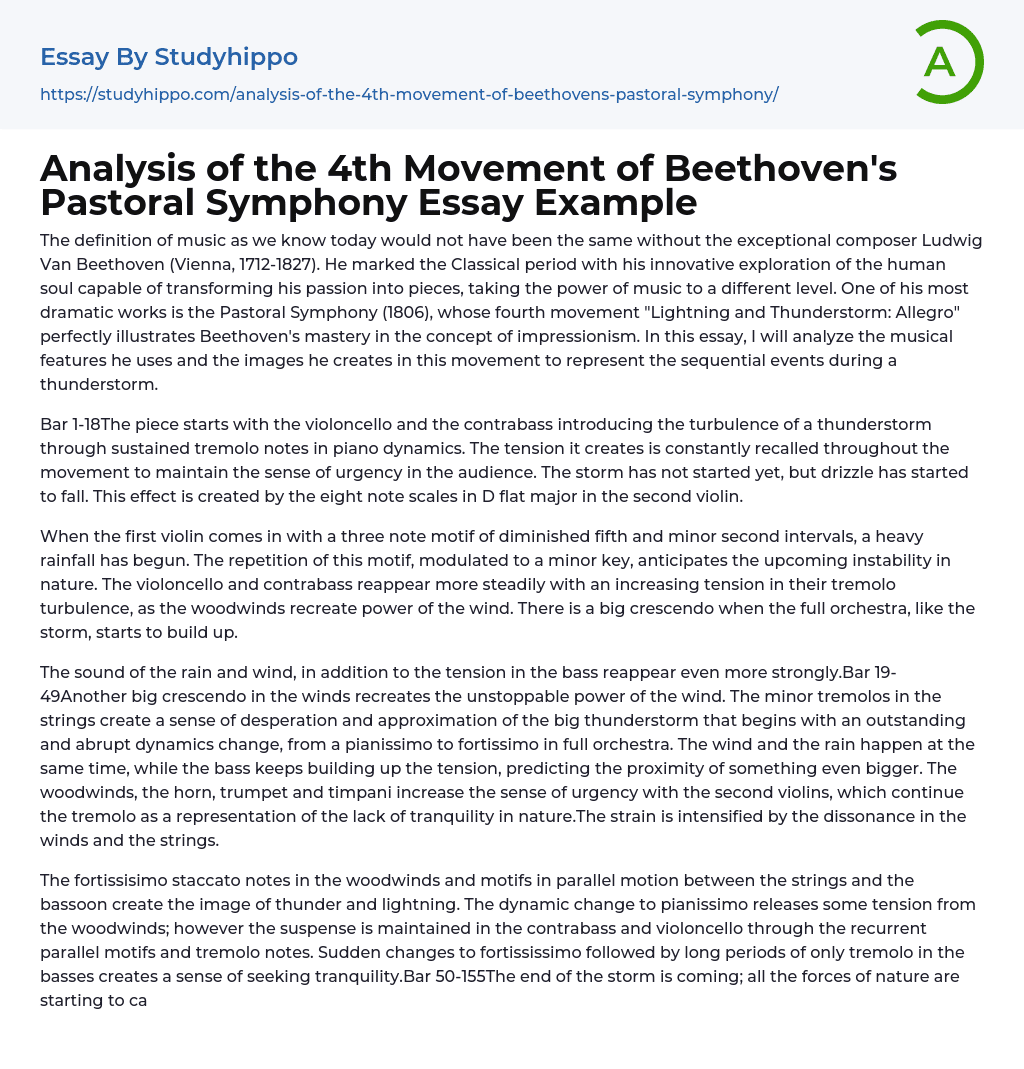

Analysis of the 4th Movement of Beethoven’s Pastoral Symphony Essay Example
The definition of music as we know today would not have been the same without the exceptional composer Ludwig Van Beethoven (Vienna, 1712-1827). He marked the Classical period with his innovative exploration of the human soul capable of transforming his passion into pieces, taking the power of music to a different level. One of his most dramatic works is the Pastoral Symphony (1806), whose fourth movement "Lightning and Thunderstorm: Allegro" perfectly illustrates Beethoven's mastery in the concept of impressionism. In this essay, I will analyze the musical features he uses and the images he creates in this movement to represent the sequential events during a thunderstorm.
Bar 1-18The piece starts with the violoncello and the contrabass introducing the turbulence of a thunderstorm through sustained tremolo notes in piano dynamics. The tension i
...t creates is constantly recalled throughout the movement to maintain the sense of urgency in the audience. The storm has not started yet, but drizzle has started to fall. This effect is created by the eight note scales in D flat major in the second violin.
When the first violin comes in with a three note motif of diminished fifth and minor second intervals, a heavy rainfall has begun. The repetition of this motif, modulated to a minor key, anticipates the upcoming instability in nature. The violoncello and contrabass reappear more steadily with an increasing tension in their tremolo turbulence, as the woodwinds recreate power of the wind. There is a big crescendo when the full orchestra, like the storm, starts to build up.
The sound of the rain and wind, in addition to the tension in the bass reappear even more strongly.Bar 19-49Another bi
crescendo in the winds recreates the unstoppable power of the wind. The minor tremolos in the strings create a sense of desperation and approximation of the big thunderstorm that begins with an outstanding and abrupt dynamics change, from a pianissimo to fortissimo in full orchestra. The wind and the rain happen at the same time, while the bass keeps building up the tension, predicting the proximity of something even bigger. The woodwinds, the horn, trumpet and timpani increase the sense of urgency with the second violins, which continue the tremolo as a representation of the lack of tranquility in nature.The strain is intensified by the dissonance in the winds and the strings.
The fortissisimo staccato notes in the woodwinds and motifs in parallel motion between the strings and the bassoon create the image of thunder and lightning. The dynamic change to pianissimo releases some tension from the woodwinds; however the suspense is maintained in the contrabass and violoncello through the recurrent parallel motifs and tremolo notes. Sudden changes to fortississimo followed by long periods of only tremolo in the basses creates a sense of seeking tranquility.Bar 50-155The end of the storm is coming; all the forces of nature are starting to calm. The staccato notes in the woodwinds and a motif in the first violin give the audience a sense of upcoming quietness and peace; although, the tremolo continues and the dissonance comes back. As the storm goes away, the dynamics change to pianissimo.
Several modulations anticipate the return of peace and tranquility. The tension of the storms keeps coming back. Calls and answers between the first violin and the flute are emphasized by the
continuing tremolo and the full orchestra themes.The violoncello and contrabass take more active part when the climax of the returning storm appears through sudden dynamic changes to fortississimo. At this point, nature is claiming some harmony and serenity.
Hence, the strings solve the tension and tonal resolution occurs, as the storm comes to its end. Some last lightning motifs and dissonance finally disappear, as the strings modulate several times until getting to a major key. There is a diminuendo that creates a new atmosphere. As the coda brings the whole piece to an end, now in C major, the storm is completely away. The oboe and the flute close the piece representing the birds singing.
The power of this composition confirms Beethoven's genius and mastery. It was able to move my emotions and provoke a reaction I had never felt. The sequence of the piece was like an open book, whose images I could endlessly follow. The flow of energy captured more than my 5 senses, it impacted deep into my soul.
I must recall the Beethoven was a genius, and his genius changed my own definition of music.
- Band essays
- Baroque Music essays
- Blues essays
- Classical Concert essays
- Classical Music essays
- Concert essays
- Hip Hop essays
- Jazz essays
- Ludwig Van Beethoven essays
- Michael Jackson essays
- Mp3 essays
- Music Concert Report essays
- Music Reference essays
- Music video essays
- Musical Instruments essays
- Opera essays
- Piano essays
- Popular music essays
- Recording essays
- Rock And Roll essays
- Rock Music essays
- Singing essays
- Sonata essays
- Song essays
- Sonnet essays
- Tupac shakur essays



